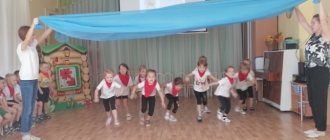Consultation for parents of preschool educational institutions. Child safety
Consultation on life safety for kindergarten parents
The main advantage of preschoolers in teaching personal safety is that children of this age follow clearly formulated instructions from their parents in connection with age-related characteristics.
It is necessary to highlight the rules of behavior that children will follow, since their health and safety depend on this. These rules should be explained in detail to children and then monitored for their implementation. The task of adults is not only to protect and protect the child, but also to prepare him to face various difficult and sometimes dangerous life situations. The child must know information about himself: first name, last name, address and telephone number.
Mark the “friend-stranger” : set rules regarding strangers and monitor their implementation. Explain to your child: a stranger is any person he does not know (regardless of how he behaves or who he imagines himself to be). To form a more accurate understanding of who is “your” and “stranger” people, ask them to depict in one drawing those people whom they consider “theirs” (mom, dad, grandmother, etc.), and in another drawing - strangers, strangers (seller, passerby, etc.). If the child depicted someone else in the first picture, in addition to family members, for example: a teacher, a mother’s friend, a friend, explain that such people are called “acquaintances.” Offer to draw them in the third picture. It wouldn't hurt to run a few learning experiments to test your understanding of these rules. For example, a mother or father can agree with an acquaintance whom the child does not know so that he tries to get to know the baby and invites him to come with him. After the experiment, of course, you need to discuss with the child his reaction. If the child is left alone at home: he must clearly understand that the door cannot be opened to ANYONE except his mother (father, grandmother - specify the circle of people). Household items that are sources of potential danger to children are divided into three groups: - items that are strictly prohibited to use (matches, gas stoves, sockets, turned on electrical appliances); - objects that, depending on the age of the children, need to be learned to handle correctly (needle, scissors, knife); - items that adults should store in places inaccessible to children (household chemicals, medicines, alcoholic beverages, cigarettes, cutting and stabbing instruments). If a fire occurs in the absence of adults, it is important for the child to know the following: - do not hide under the table, in the closet or under the bed (firefighters may not immediately notice the child and may not have time to save him); - If possible, run out onto the balcony or look out the window and scream for help.
Child safety on the street
When preparing your child to go to school independently or ride a bike in the yard, you should walk around the entire yard with him, noting potentially dangerous places.
Make an agreement with your child, according to which he will only move along the safe route agreed with you and will not take shortcuts, especially in desert areas.
This agreement is the basis of street safety. The child must remember the following rules. 1.Do not go outside without adults. 2.Do not play on the sidewalk near the roadway. 3. Cross the road only at a pedestrian crossing when the traffic light is green. 4. Ride a bicycle in the city only where there are no cars. 5. Small children should ride a bicycle only in the presence of adults; children of older preschool age, even in the presence of adults, should not ride a bicycle on the sidewalk, as they can interfere with pedestrians, run over a small child, hit an elderly person, push a stroller with a baby .
6.Be attentive, but not overly cautious or cowardly. 7. It’s good to know the landmarks in the area of your home. 8.Walk in the middle of the sidewalk, avoiding bushes and doors, especially abandoned houses. 9.Know all the safe places where you can hide and get help. 10.Do not attract attention to yourself by your demeanor.
Safety in public transport
Parents should remember that young children should not travel on public transport without an adult. But gradually children need to be prepared for this. For example, the child should know his route well, mainly the pick-up and drop-off stations. He must also know all the landmarks and street names along the route. Explain to your child that he must see and notice everything.
Advise your child to sit next to the driver or controller and wait for the bus only in a well-lit place.
Of course, strengthen your child’s faith in his own instinct. He should leave as soon as he feels any discomfort. If a stranger speaks to him, he needs to attract the attention of others so that if necessary, someone can come to his aid. When using public transport, the following rules must be observed. 1. You cannot show money to attract attention. 2. You cannot go close to the edge of the road when boarding a bus, especially during icy periods. 3. You cannot stand at the doors - this interferes with the entry and exit of passengers. 4.You cannot lean out or stick your hands out of open windows. 5. It is customary to give way to elderly people, passengers with small children, and disabled people. “Road Safety” You can cross the street only at pedestrian crossings. They are indicated by a special sign “Pedestrian crossing”
If there is no underground crossing, you must use a crossing with a traffic light. Outside populated areas, children are only allowed to walk with adults along the edge towards cars. If your parents have forgotten which side to go around a bus or tram, you can remind them that it is dangerous to go around these vehicles both in front and behind. You need to go to the nearest pedestrian crossing and cross the street along it. Under no circumstances should you run out onto the road. You have to stop before the road. You cannot play on the roadway or on the sidewalk. It is safest to cross the street in a group with a group of pedestrians. When the car is moving: — teach children to sit in the car only in the back seat; do not allow anyone to sit next to the driver unless the front seat is equipped with a child seat; — do not allow a small child to stand in the back seat while driving: in the event of a collision or sudden stop, he may fly over the back of the seat and hit the front window; - Do not allow children to be in the vehicle unattended.
The best way to teach children has always been by example.
If you want to teach your child safety rules, first of all, follow them yourself. Talk to your children as often as possible and help them solve even minor problems. Recommendations for parents on safety
Dear parents! You are a role model for children. You are an object of love and imitation for a child. This must always be remembered, and even more so when you take a step onto the roadway with your baby.
To prevent your child from getting into trouble, teach him respect for the rules of the road patiently, daily, unobtrusively. The child should only play in the yard under your supervision. He must know: you can’t go out on the road. Do not intimidate the child, but watch with him and take advantage of the situation on the road, yard, street; Explain what happens to transport and pedestrians. Develop your child's visual memory and attention. To do this, create game situations at home. Let your baby lead you to kindergarten and home from kindergarten. Your child should know: you can’t go out on the road; You can cross the road only with adults, holding the hand of an adult; you need to cross the road at a calm pace; pedestrians are people walking along the street; in order for there to be order on the road, so that there are no accidents, so that a pedestrian does not get hit by a car, you must obey the traffic light: red light - no traffic, yellow light - attention, and green says: “Pass the path is open”; There are different types of cars (trucks, cars); this is transport. The cars are driven by drivers. The highway (road) is intended for transport. When we travel in public transport, we are called passengers. While riding in public transport, you should not lean out of the window.
We recommend watching:
Consultation for parents on traffic rules. Safe road Safety of conducting classes on the playground and in the gym Notes of a lesson on fire safety in the preparatory group Notes of a lesson on life safety in the middle group
Similar articles:
Summary of a lesson on life safety for kindergarten on the topic: In the world of dangerous objects
Summary of a lesson on cognitive development in the senior group. Poisonous mushrooms and berries
Lesson on basic safety in the senior group. Topic: Meeting a stranger
Summary of a lesson on life safety in the middle group. Visiting Doctor Aibolit
Summary of a lesson on life safety in the middle group on the topic “Preparation of vinaigrette (salad)”




